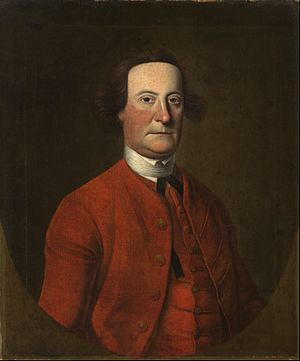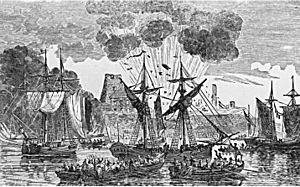John Bradstreet facts for kids
Quick facts for kids
John Bradstreet
|
|
|---|---|

Portrait of Bradstreet by Thomas McIlworth, (1764).
|
|
| Born | 21 December 1714 Annapolis Royal, Nova Scotia |
| Died | 25 September 1774 (aged 59) New York City, British America |
| Allegiance | |
| Service/ |
|
| Years of service | 1735–1774 |
| Rank | Major-General |
| Commands held | Expeditionary force to Fort Frontenac |
| Battles/wars | King George's War French and Indian War Pontiac's War |
John Bradstreet (born Jean-Baptiste Bradstreet) was an important officer in the British Army. He lived from 1714 to 1774. John Bradstreet fought in several big wars, including King George's War, the French and Indian War, and Pontiac's War. He was born in Annapolis Royal, Nova Scotia. His father was a British Army officer, and his mother was from Acadia. He also served as the Commodore-Governor for Newfoundland.
Contents
Early Life and Family
John Bradstreet was born on December 21, 1714. His birth name was Jean-Baptiste Bradstreet. His mother was Agathe de Saint Etienne de La Tour. His father was Edward Bradstreet. John Bradstreet passed away in New York City on September 25, 1774. He was married and had two children.
Bradstreet's Military Career
John Bradstreet joined the British Army in 1735. His mother's family helped him get accepted. At first, he served in Nova Scotia with the 40th Regiment of Foot. He used his Acadian background to trade with the French in Louisbourg.
King George's War Experience
During King George's War, Bradstreet was stationed at Canso. French forces captured him during a raid. He was released within a year. While he was held captive, Bradstreet thought of plans to capture Louisbourg. He was not given command of the mission. However, he became a lieutenant-colonel in the 1st Massachusetts Regiment. He helped the British win the siege of Louisbourg in 1745.
Fighting in the French and Indian War
In 1755, Bradstreet became an adjutant general. This meant he helped Governor William Shirley with army matters. In 1756, he led a group to bring supplies to Fort Oswego. On his way back, French and Native American forces attacked him. He survived the attack. Bradstreet warned leaders that Fort Oswego was weak. But his warnings were not fully listened to. The French later captured and burned Oswego that same year.
In 1757, Bradstreet helped gather supplies for an attack on Louisbourg. This attack was later called off. In 1758, he took part in the Battle of Carillon. He led the advance group after General George Howe died. The battle was a disaster for the British. Bradstreet tried to organize a retreat, but it became very messy.
After this defeat, Bradstreet suggested attacking Fort Frontenac. This fort was a key French supply base on Lake Ontario. British leaders liked his idea. He was given about 3,000 men for the mission. Bradstreet reached Lake Ontario on August 21. Four days later, his forces saw the fort. Fort Frontenac surrendered on August 27. Bradstreet's men destroyed the fort and its supplies. Then they returned to British territory. This attack cut off French supplies in the Great Lakes for a time. Bradstreet then worked as a deputy quartermaster general in Albany. This was an important job until the war ended.
Role in Pontiac's War
After the French and Indian War, Bradstreet became a colonel in 1764. He was ordered to lead 1,400 men to Fort Detroit. This was to help during Pontiac's War. Some leaders thought Bradstreet did not manage this mission well. They felt he tried to make peace treaties on his own. They also thought he was not aggressive enough against Pontiac's forces. This hurt his military reputation later on. However, he was still promoted to Major General in the British Army in 1772.
Organizing Transport Services
John Bradstreet is also remembered for his work with boats. He helped create a group of armed boatmen and teamsters. Their job was to move supplies and troops along rivers and lakes. This was a huge task. The group grew to thousands of men. They used hundreds of bateaux (flat-bottomed boats) and whaleboats. They moved tons of supplies and equipment. This was very important for the British to fight wars in the colonial Northwest. These "Battoe Men" also took part in battles. A famous example is Bradstreet's attack on Fort Frontenac in 1758.
See also


